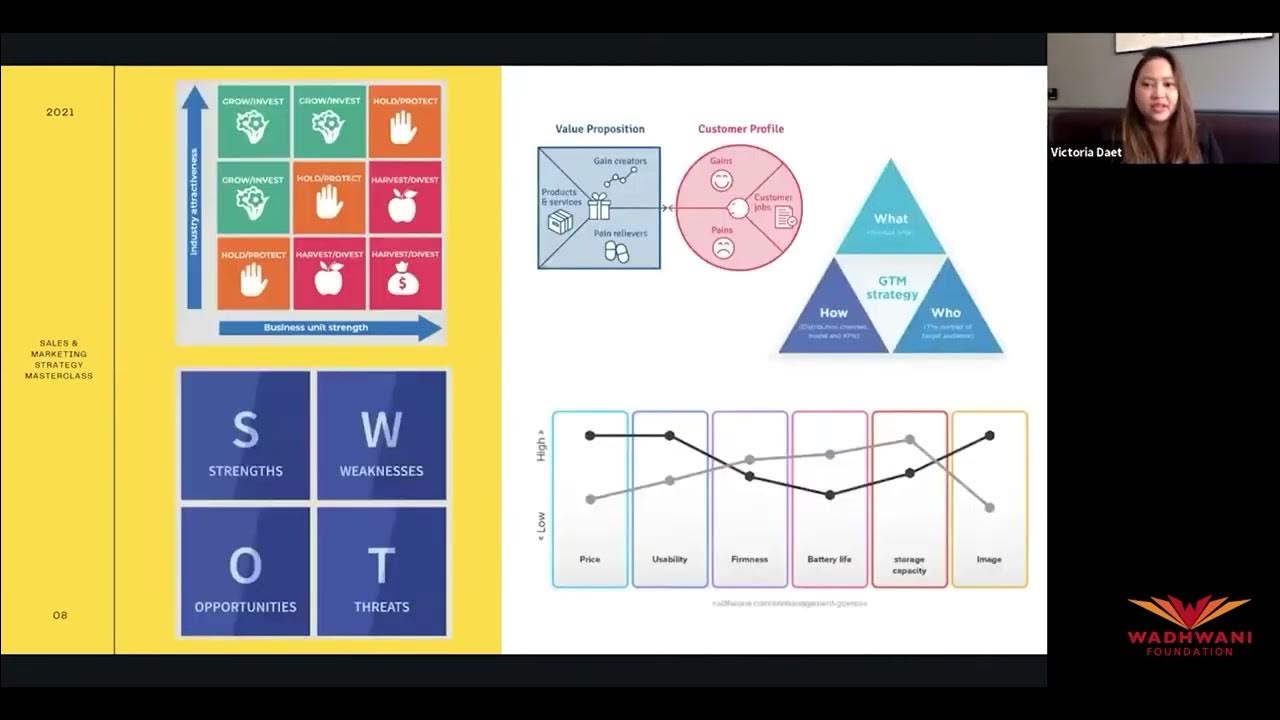How to Position your Startup with Rob Kaminski
Summary
TLDRIn this insightful presentation, Rob shares valuable strategies for early-stage B2B startups to achieve product-market fit. He emphasizes the importance of identifying and dominating specific market segments, presenting a framework for crafting compelling positioning and messaging. Rob highlights the fragmentation of B2B markets and the need to start small, focusing on nailing one use case before expanding. He provides actionable principles for effective messaging, such as leading with capabilities, sharing first-order benefits, and addressing surface-level problems. Overall, Rob's practical advice and proven methodologies offer a roadmap for founders to navigate the complexities of finding product-market fit and driving growth.
Takeaways
- 😄 Product-market fit is achieved when you can repeatedly find, sell, serve, and retain customers across the same use case.
- 😎 B2B markets are incredibly fragmented, and product-market fit is a collection of multiple fits across different segments or 'cubes'.
- 🤔 When positioning your product, focus on a specific use case and target audience, rather than trying to appeal to everyone.
- 💡 Lead with the capabilities of your product (what it can do) and the first-order benefits, not abstract outcomes or higher-level benefits.
- 🎯 Message on the surface-level problems your target customers are facing, not the root cause you're solving.
- 🌱 Start small and dominate a narrow market before expanding, even for successful startups like Facebook and PayPal.
- 📈 Achieving product-market fit takes years, not months, for most startups. Expect a 5+ year journey.
- 💰 Raise funds only after achieving a good portion of product-market fit, not to figure it out along the way.
- 🔍 Immerse yourself in your target customer base to truly understand their problems and get qualitative insights.
- 🧭 If customers aren't willing to give you their time and money, it's likely a market problem, not a product problem.
Q & A
What is the 'leaky bucket' concept in SaaS?
-The 'leaky bucket' concept refers to a situation where a SaaS product is able to attract customers but fails to retain them due to the product not fully meeting their needs or expectations.
What does Fletch specialize in?
-Fletch is a product marketing consultancy for early-stage B2B startups, focusing on positioning, messaging, and translating messaging into clear homepage copy.
How does Fletch define product-market fit?
-Fletch defines product-market fit as the ability to repeatedly find, sell, serve, and retain customers across the same use case.
What are the two approaches to finding product-market fit mentioned in the script?
-The two approaches are starting with a market problem or insight and then figuring out what to build to capture that opportunity, and starting by building a product with potential use cases but without a clear target audience.
What is the 'Minimum Viable Positioning' framework?
-The Minimum Viable Positioning framework is a guide developed by Fletch to help founders sort through different positioning options to find the most clear and compelling for their stage.
Why is it important to start small when finding product-market fit?
-Starting small is crucial because it allows a startup to dominate early markets, ensuring a strong foothold before expanding to capture larger segments.
How does Fletch recommend explaining a product for positioning?
-Fletch recommends finding reference points to explain your product either based on its use case or by comparing it to known products, methods, or competitors as competitive anchors.
Why is it advised against overcomplicating positioning?
-Overcomplicating positioning leads to analysis paralysis, preventing clear decision-making and delaying testing of positioning in the real world where feedback is crucial.
What is the importance of focusing on go-to-market fit first?
-Focusing on go-to-market fit first is important because it brings a startup closer to customers, offering a better view into the problem and increasing the chances of finding a market fit.
How should startups view their market when considering product-market fit?
-Startups should view their market in detail, recognizing its fragmentation and understanding that product-market fit at scale is actually a collection of multiple fits within smaller, targeted segments.
Outlines

Dieser Bereich ist nur für Premium-Benutzer verfügbar. Bitte führen Sie ein Upgrade durch, um auf diesen Abschnitt zuzugreifen.
Upgrade durchführenMindmap

Dieser Bereich ist nur für Premium-Benutzer verfügbar. Bitte führen Sie ein Upgrade durch, um auf diesen Abschnitt zuzugreifen.
Upgrade durchführenKeywords

Dieser Bereich ist nur für Premium-Benutzer verfügbar. Bitte führen Sie ein Upgrade durch, um auf diesen Abschnitt zuzugreifen.
Upgrade durchführenHighlights

Dieser Bereich ist nur für Premium-Benutzer verfügbar. Bitte führen Sie ein Upgrade durch, um auf diesen Abschnitt zuzugreifen.
Upgrade durchführenTranscripts

Dieser Bereich ist nur für Premium-Benutzer verfügbar. Bitte führen Sie ein Upgrade durch, um auf diesen Abschnitt zuzugreifen.
Upgrade durchführenWeitere ähnliche Videos ansehen

8 B2B Marketing Strategies That Got My Startup to $10 Million (and 1 that FAILED)

Week 10 Masterclass- Victoria Daet: Strategic Growth Blueprint

The Multipreneur: He’s Building A $10M Portfolio of Income Streams

Week 13 Masterclass Sanjay Mehta 100X VC Criteria for Venture Evaluation

The Fundraising Process : Preparation phase - Startup valuation

[EXCLUSIVE] Harshil Mathur on Journey of Razorpay, User Specific Fintech the & Raising VC Money
5.0 / 5 (0 votes)
